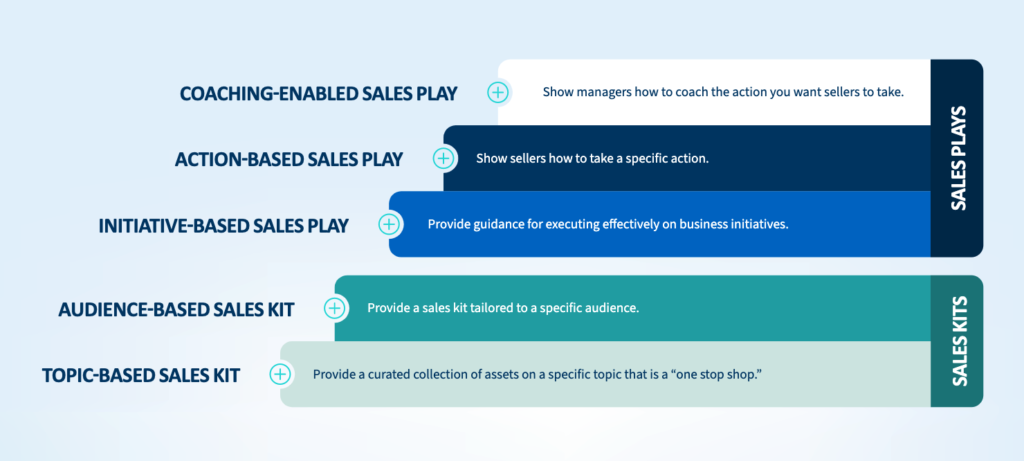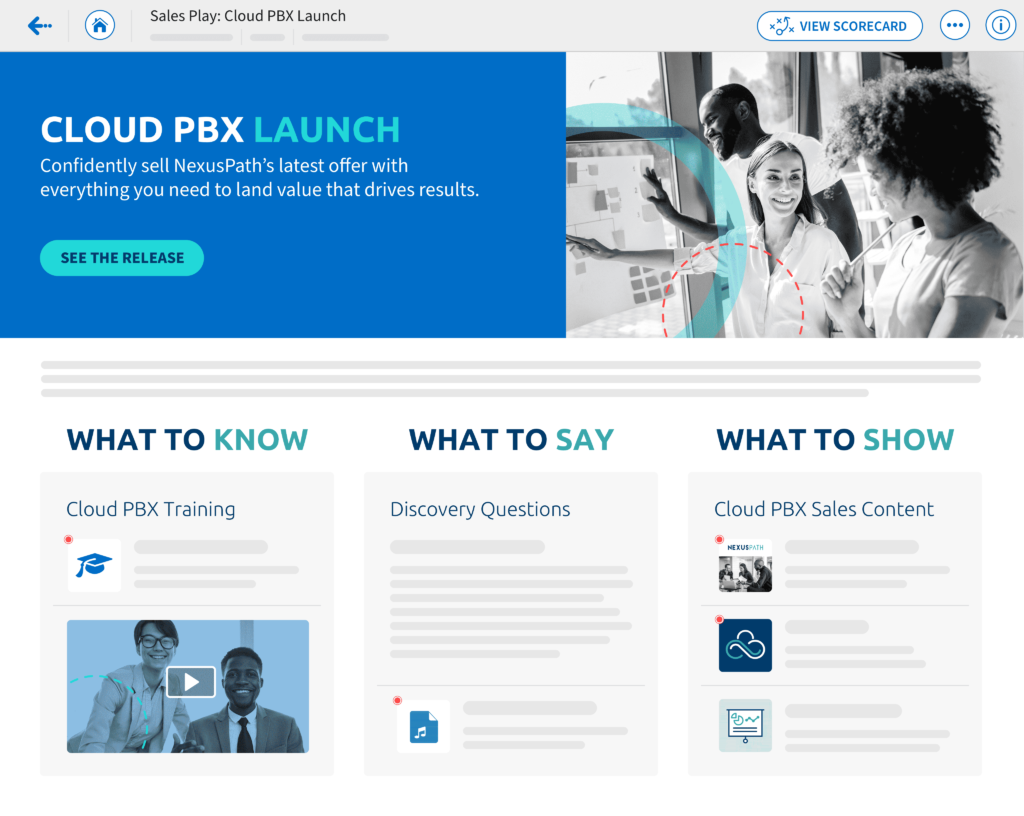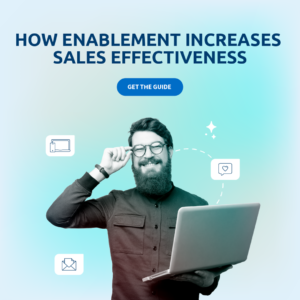You’ve built your sales strategy. You’ve rolled out your sales methodology. Now how do you ensure your sales team can effectively execute these actions in the field?
Enter sales playbooks. These handy guides exist to empower salespeople with everything they need to know simply and repeatedly bring your sales strategy to life in the field.
Let’s take a look at the essentials of crafting and deploying impactful sales playbooks including:
What is a sales playbook?
A sales playbook refers to any means of codifying and documenting sales best practices. A good sales playbook should tell reps specifically what to know, say, show, and do for any given customer scenario. This ensures that reps can execute your sales strategy effectively in the field – and close more deals.
Before the advent of digital sales, sales playbooks were literally that – huge physical binders of call scripts, guidance, and other resources salespeople could use to engage buyers. As sales itself has evolved, so have playbooks. Modern versions now reside online – typically within a sales enablement platform – which allows reps easy, in-the-moment access to best practices wherever they are working.
What is the difference between a sales playbook vs. a sales kit vs. a sales play?
Besides sales playbooks, you may have also heard of sales plays or sales kits. Each of these terms refers to a method of guiding sales reps through the sales process. However, where a sales playbook may comprise many different plays and kits, sales plays and sales kits are intended for specific use cases. Let’s take a closer look at their differences.

What is a sales play?
A sales play refers to a set of best practices designed for a specific customer scenario. A sales playbook is a collection of many different sales plays. Sales plays can be created to support different regions, product lines, or buyer personas; this ensures that your reps’ tactics match different buyer needs. Sales play content should provide context around what you are asking sellers to do, show sellers how to take that specific action, and tell managers how to coach against that action.
What is a sales kit?
Like a sales play, a sales kit provides guidance on a specific topic or initiative. However, whereas sales plays are focused on telling reps what to know, say, show, and do, a sales kit narrows in on “what to know” and “what content to show” buyers – such as talking points, and email pitch templates. Sales kits operate as a one-stop shop to help sales reps take action.
Why are sales playbooks important?
Sales playbooks – along with sales plays and sales kits – are important because they empower reps to correctly put your sales strategy into action during customer interactions. No matter how your strategy changes – whether that’s selling something new, deploying a new methodology, or entering a new region – sales playbooks ensure that reps know what to do, and how to do it effectively.
To get a better understanding of their impact, let’s imagine you are rolling out a new product line. How should reps talk about this product line? What value does this new product provide to the customer? What new content exists for a rep to send the customer?
Without the clear, codified guidance sales plays provide, reps would be left to pick and choose which actions to take (or not take!) on their own. This will lead to uneven results: some reps may find their own way to sell the new product; others will struggle and fail to meet quota. The success of your new product line is not guaranteed.
Instead of letting reps guess and check what works, you can codify best practices by updating your sales playbook with a new sales play that supports the new product line. As reps begin to sell the product, they can access the sales play to understand which actions they should take and why. With best practices laid out for them, it is much more likely that all your reps will succeed, and that your business will hit its revenue targets.
What are sales motions?
The term sales motion refers to the particular method sales organisations use to bring a product or service to market. In simple terms, it’s how your sales team operates – how it is structured, how territories are determined, how pipeline is generated, and so on. Sales motions are defined by your larger go-to-market strategy.
Learn more about how sales motions fit into your sales strategy with our guide to choosing a sales model and this breakdown for sales organisational structures.
What should be in a sales playbook?
A sales playbook should comprise many different sales plays and sales kits to support specific scenarios. Cumulatively, this knowledge should guide sellers through any customer conversation, at any stage of the sales funnel.
While your sales playbook should be specific to your company, a good rule of thumb is to make sure the following sales plays are included:
- Persona: Tailored to specific buyer personas
- Compete: Tailored to over landing competitive differentiators and overcoming objections
- Prospecting: Tailored to your approach to prospecting
- Demo: Details demo best-practices
- Product: Details approach for specific product line
- Region/Territory: Supports regional activities, such as field events
- Closing: Guides sellers on how to close deals, including working with intra-company functions like legal and deal desk
- Post Sales: Details the post-sale handoffs
- Renewal/Cross-Sell/Up-Sell: Supports post-sale motions, with updated messaging for existing customers
Download our ultimate guide to sales plays for a breakdown of essential elements to include in each play.
How do you roll out a sales playbook to the field?
The key to rolling a sales playbook out in the field is sales enablement.
 First, your sales enablement platform should house your sales playbook. Sales enablement platforms come in many shapes and sizes but the one thing they all have in common is their ability to operate as a single source of truth for reps to find the content, guidance, and training they are looking for. A great sales enablement platform will allow you to build your sales playbook in-platform. For instance, Highspot enables sales enablement professionals to quickly build richly formatted sales plays via our SmartPage technology.
First, your sales enablement platform should house your sales playbook. Sales enablement platforms come in many shapes and sizes but the one thing they all have in common is their ability to operate as a single source of truth for reps to find the content, guidance, and training they are looking for. A great sales enablement platform will allow you to build your sales playbook in-platform. For instance, Highspot enables sales enablement professionals to quickly build richly formatted sales plays via our SmartPage technology.
Second, your sales enablement team should orchestrate the creation and maintenance of your sales playbook. Acting as the essential link between sales and other stakeholders, like Marketing or executive leadership, enablement practitioners should work to align the entire organisation on goals, then codify how the business will meet them in a playbook.
Your enablement function is also responsible for socialising your playbook with your sales team and achieving rep buy-in. Enablement practitioners can do this by communicating this level from the top down, leveraging executive voices to explain the value proposition for reps. But they should also create accountability through frontline managers and empower these leaders to lead and coach against the best practices in your playbook.
Six steps to craft the perfect sales playbook
Ready to build a sales playbook that’s sure to set reps up for success? Follow these six steps to get started.
1. Align your go-to-market teams
Before you even begin to write down best practices, you must first understand what it is that you are trying to achieve. Most businesses have an idea of their sales strategy and goals such as “hit X-million in revenue” or “enter a new market”. However, when it comes to creating sales playbooks, you’ll need to be more specific on how you intend to achieve that.
Because sales playbooks require you to document specific actions reps need to take in order to achieve that goal, GTM teams need to understand which initiatives are necessary to make that goal a reality. If your goal is to sell a new product line, then your initiatives should be based around the new behaviours, skills, tools, and content reps will need in order to sell that product in the field. Enablement is the natural team to lead these discussions and creating a sales playbook is an excellent catalyst to create clarity and drive alignment.
2. Speak to your sales reps
It is essential that you involve sales reps in the process of developing your sales playbook. After all, their success rests on the value of the playbook’s content. Soliciting rep feedback shouldn’t be a one-time event; great enablement teams should regularly source and incorporate seller perspectives into their work.
For instance, at the start of any playbook, play, or kit development, you should ask reps for insight into where they are struggling. Perhaps they are missing a piece of content or maybe messaging isn’t resonating with customers. Let their perspective guide how you think about the initiatives, training, and content you are developing. You can achieve this formally through advisory groups or surveys. But don’t discount the power of pinging a rep for a quick take on content. You may be surprised by what they have to say.
3. Use a sales methodology
Sales methodologies are integral to creating a sales playbook. That is because your sales methodology typically prescribes an overall approach to selling – from your messaging to your sales process. If you don’t already have a sales methodology, it’s time to select one. To do so, think about the type of product you sell and the type of customer you sell to. Whether you’re an innovative startup looking to break through the status quo or an industry giant selling complex solutions, who you sell to and what you sell will determine the best methodology for your business.
If you have a sales methodology in place, consider bringing it into your sales enablement platform. Modern platforms offer marketplaces that allow you to install your chosen methodology into your platform. This ensures that reps only ever have to access one solution – your sales enablement platform – to find the guidance, training, and content they need. It also means it will be easier than ever to integrate methodology content into your sales playbook.
4. Develop sales playbook, play, and kit content and training
Once you have a clear idea of what you are going to do, it’s time to make it real by developing content, training, and coaching materials to support your initiative. A word of caution, however: Often, organisations feel that new things demand new everything. But doing more isn’t necessarily a viable path to developing effective playbooks. Instead, it can have the effect of overwhelming reps.
Rather, start this process by auditing what you have. A heatmap analysis of your current content can reveal which of your sales assets are performing well and which aren’t. Likewise, in-platform reporting from your enablement solution can deliver similar insights for your training materials. Use this data to inform your own best practices on which formats, messaging, and tactics are currently working. From there, invest wisely to develop resources that put quality over quantity.
5. Socialise your sales playbook
Landing your sales playbook with your sales organisation requires buy-in from the entire team – your sales leaders, all the way down to your field reps. If you followed the steps outlined above, your sales org should have been included in some of the development processes and will have an idea of what’s going on. Still, you want to launch the final product strategically to ensure adoption in the long run.
Prepare to take your playbook on a roadshow of sorts – start by announcing changes through top-level leadership. Leaders should communicate why it matters and what’s in it for reps. You should meet with managers to walk them through changes, and train them on how to coach against new behaviours. Finally, use your tech stack to reinforce your message by surfacing your new playbook front and center in your enablement platform.
6. Measure the impact and optimise your efforts
Sales playbooks are not set-it-and-forget-it materials. They should act as living, breathing documents that are updated routinely as new information is collected. This means you need to be prepared to measure the adoption and impact of your playbook. Volume metrics can speak to adoption: how many people have viewed the sales playbook? How long have they spent looking at it? Which content asset is being used the most?
Impact and effectiveness must be inferred from other sales metrics or data streams. For instance, can sellers demonstrate mastery of a new behaviour in a recorded video or role-playing session? Are managers being held accountable for their role in landing the new playbook? Armed with a modern enablement platform, finding the answers to these questions should be easier than ever.

Scale Success with Effective Sales Playbooks
With a strategic approach to building, landing, and optimising sales playbooks, you are sure to have everything you need to empower your sales team to navigate any customer scenario and close more deals.
Go deeper into the world of sales playbooks, plays, and kits with our expert-led guide to strategic sales enablement – download your copy today.


